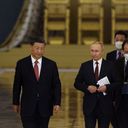A U.S. arms race with Russia and China could spin out of control

The U.S. suddenly faces a new arms race that could be more dangerous than the Cold War: This time there will be three nuclear superpowers.
The big picture: China is on track to become a nuclear peer with the U.S. and Russia — and Moscow and Beijing have shown signs they could align against Washington.
- Chinese President Xi Jinping's apparent determination to close the gap with the Cold War-era nuclear behemoths, and his increasingly close relations with Russian President Vladimir Putin, mean the next arms race could be more unpredictable than the last one.
Driving the news: Beijing's arsenal is still a fraction of the size of Moscow's or Washington's, but a new reactor that's expected to come online this year could allow China to accelerate its already rapid build-up, the NYT reports.
- China has worked with Russia to prepare the new reactor and claims it's for civilian purposes, but the Pentagon has its doubts, the Times reports.
- Liu Pengyu, a spokesperson from the Chinese embassy in D.C., told Axios the U.S. “sits on the largest and most advanced nuclear arsenal in the world,” while China is the only major nuclear power committed to a purely defensive policy. Liu also claimed the U.S. was “the single largest source of risks for international peace and security.”
- China is already on track to roughly quadruple its stockpile of nuclear warheads to around 1,500 by 2035, according to the Pentagon.
Breaking it down: While that's still less than half of what the U.S. and Russia each possess, China is also reportedly building new nuclear silos, mobile missile launchers and more advanced nuclear submarines.
- Some experts argue the build-up is largely a response to Washington's own ongoing nuclear modernization — which could cost $2 trillion over 30 years — with Beijing striving to ensure its nuclear capabilities could survive a U.S. first strike.
Russia is also developing new nuclear delivery systems.
- Putin announced in February that Russia was suspending its participation in New START, the last remaining U.S.-Russia arms control pact. Caps on the size of the countries' arsenals under the treaty expire in three years.
- The Trump administration tried to pressure China into three-way arms control talks in 2020, but failed. Arms control itself will likely soon be extinct, at least as it applies to the major powers.
U.S. nuclear policy is based first on deterrence, and then on the idea that if nuclear war can’t be averted, the U.S. must be able to destroy as much of an enemy’s nuclear forces as possible before they can be used against the U.S. or its allies, says Jon Wolfsthal, senior adviser at Global Zero and former senior director on the National Security Council under Barack Obama.
- Now, some in the U.S. government and military are arguing the U.S. needs to be equipped to fight Russia and China at the same time, says James Acton, director of the Carnegie Endowment's nuclear policy program.
- Acton worries we're entering an almost unstoppable three-way arms race. "At least in the Cold War, we could say, 'Okay, we'll accept parity with the Soviets,'" he says. In a three-way arms race, the U.S. will be unwilling to accept parity with either Russia or China, but neither of them will accept anything other than parity with the U.S.
- In reality, Acton believes enough of the Chinese or Russian nuclear program would almost certainly survive a U.S. first strike for either country to inflict "civilization-ending damage" in return. But the fact that the arms race "won't make us safer" doesn't mean it won't happen, he says.
What to watch: The prospect of a major power using nuclear weapons looms larger than at any time in decades, given Putin's nuclear threats in Ukraine.
- China still maintains a "no first use" policy and says its nuclear weapons are only for deterrence.
- But as Max Boot argues in the Washington Post, it's hardly impossible to envision a scenario in which a conflict with China over Taiwan could go nuclear.
- It wasn't until the U.S. and the Soviet Union reached the brink of nuclear war, during the Cuban Missile Crisis, that they began to build guardrails and reduce their stockpiles, Acton notes.
For now, all three countries are heading in the opposite direction.
Editor's note: This story has been updated with comment from the Chinese embassy and corrected to reflect that U.S. nuclear policy is based first on deterrence (not solely on the idea of being able to preemptively destroy an enemy's nuclear forces before they can be used against the U.S.).